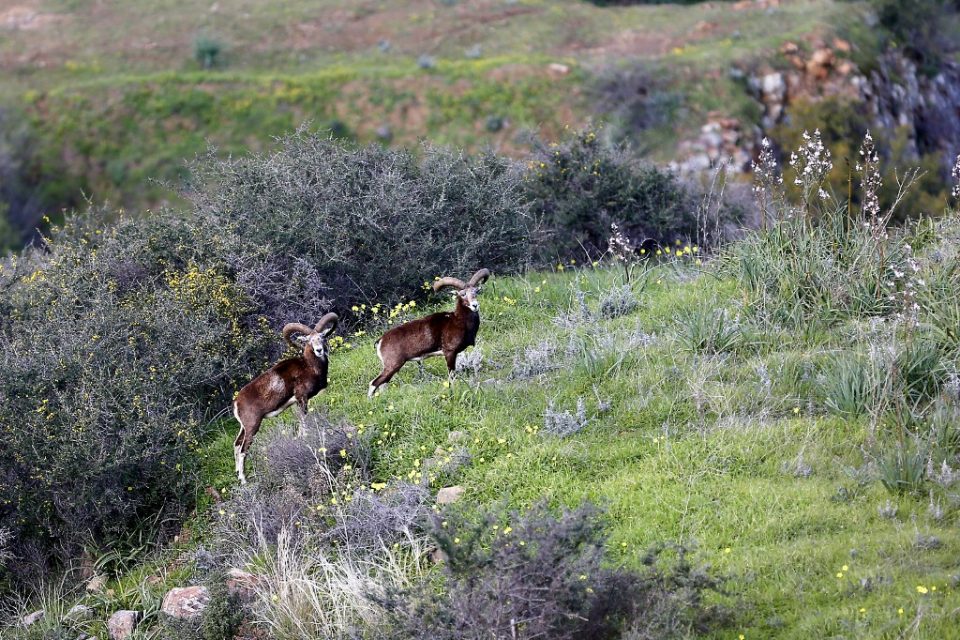
by Claire Gounon
GERAKIES, Cyprus (AFP) — Surveying his orchard in the Troodos Mountains, Cypriot farmer John Papadouris is convinced the island’s treasured wild sheep would have destroyed his crop without action.
With the males’ distinct arched horns, the mouflon is a national symbol of Cyprus, where it has roamed for thousands of years and is protected by law.
But after making their home in the western forests of Paphos, they have been creeping east into the agricultural villages of the Marathassa Valley — much to the anger of farmers whose crops they damage.
Papadouris, a former mayor of the valley’s main village Kalopanayiotis, 75 kilometers (45 miles) west of the island’s capital Nicosia, said he had spent “a lot of money” fencing his orchard to protect it from the animals searching for food.
“I can afford to fence it but I have to say that the villagers up here are desperate,” he said.
“Some of the villagers have been forced out by the mouflon.”
Christodoulos Orphanides, mayor of Tsakistra village, pointed to a vineyard which he said could produce three tonnes of grapes.
“At this given moment, the producer cannot even pick up 30 kilograms because (at night there are)… up to 40 mouflon eating the vines,” he told AFP.
Orphanides also owns six hectares (14.8 acres) of orchards, including cherry trees but said that he can only harvest the very highest fruit which the mouflon cannot reach.
– Fencing farms –
The mouflon problem has been exacerbated by years of dry weather, prompting the animals to seek out the most humid areas of the mountains, according to Nicos Kasinis, of the interior ministry.
Planned reforestation has rendered much of the Paphos Forest uninhabitable for the mouflon, while at the same time the animals have benefited from new protection regulations.
There are now around 3,000 mouflon, compared to just a few dozen in the mid-20th century, Kasinis said.
The rebound in their numbers followed a hunting ban in Paphos Forest, introduced 80 years ago, and subsequent measures to strengthen their protection.
The mouflon is described as “an indispensable part of our natural heritage” by the Cypriot agriculture ministry, which credits the conservation measures taken with saving the subspecies from extinction.
While acknowledging the damage done by the wild sheep can amount to hundreds or thousands of euros (dollars), Kasinis said there were some “exaggerated” complaints about the mouflon.
“They could have prevented (damage) in some parts of (the) mouflon’s range by putting up fencing themselves with very low costs.
“Some of them did it, but many people don’t do it and they expect the government to pay for it,” he said.
Before Cyprus joined the European Union in 2004, “things were easier” according to the agriculture ministry’s Chloe Kola Christofi.
“We could just give them (farmers) some money as compensation and everybody was happy,” she said.
But Brussels deemed such financial support to be contrary to European law, prompting Nicosia to scrap the compensation.
More recent EU rules however offer fresh hope for Cypriot farmers.
‘Already too late’
Under the new environmental protection directives, Nicosia submitted two assistance plans to Brussels amounting to 500,000 euros ($560,000) which were approved in January.
One grants compensation for damage suffered by farmers, while the other provides up to 40 percent of the costs to fence off crops.
But, said Costas Gabriel, a farmer in Gerakies village who owns 1,200 trees: “The money they give us is peanuts.”
He says he has already spent 10,000 euros and will spend a further 5,000 euros to protect his crop.
“I feel so much anger, not for the mouflon, we love them,” said Gabriel.
“But if the government doesn’t act more, in two, three years, there will be no one in the mountain,” he said. “And yet, it’s a wonderful place here.”
His neighbour Pambos Charalambous, who owns 300 fruit trees, claimed “only the mouflon will stay!”
Charalambous hopes for state assistance to extend his orchards, but he is pessimistic about the village’s future.
The year-round population of Gerakies, like most of the Marathassa Valley villages, has dwindled to barely 100 as the young have left in search of opportunity in the island’s cities.
“It is already too late. In five or 10 years, we’ll be alone,” Charalambous said.
“Our children are not stupid, they understood they have no chance in Gerakies.”
© Agence France-Presse
